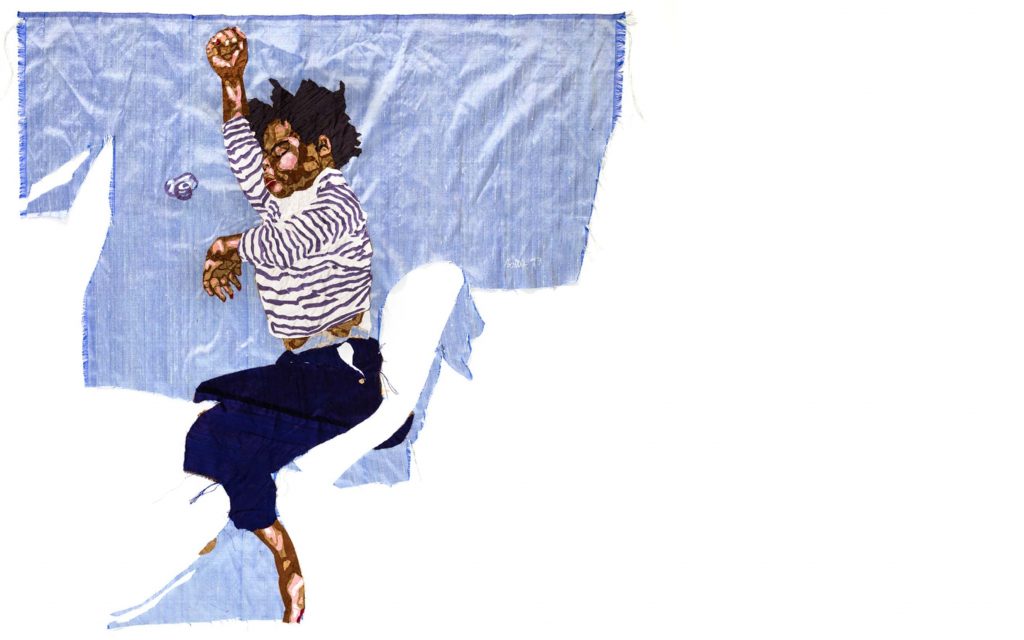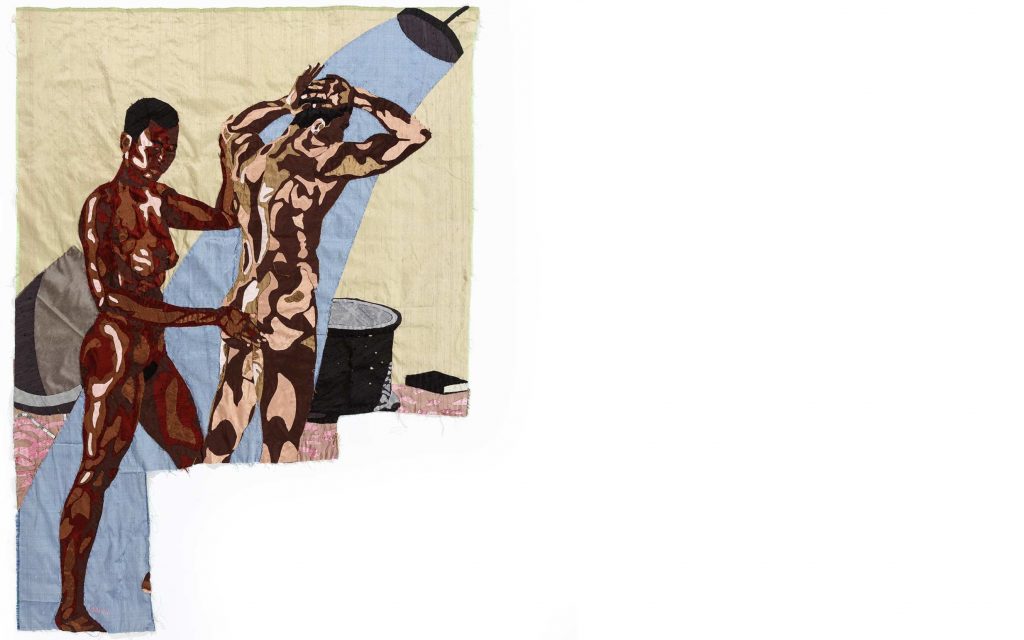TOPIC 1 POLITICAL DIMENSIONS
In the course material I read the following: In this topic, you will examine the practices of artists who use their work explicitly or implicitly to address social and political concerns using visual means. They may seek to uncover past or present injustices or shift personal or societal attitudes. Rather than analysing these works through different texts you will critically look at them and bring your own analysis to them.
GENDER
Exercise 5 Feminist Art of 1970’s
- Choose a particular artist to focus on and choose three works by them
- Make a list for each work in your learning log of exactly what you see in the image of the work.
- Be as specific as you can and include as many details as possible.
Mary Kelly (born 1940-)
Ante Partum, 1973
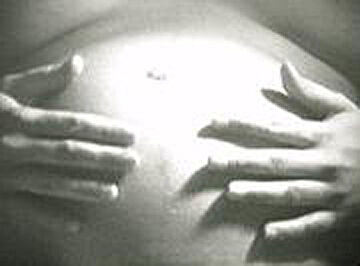
- Above image is a still form a video installation of the artist.
- This is a close up photo of her pregnant belly.
- The body as being pregnant is the object/site, because the image is so ‘zoomed in’ on it.
- She holds her hands in a protective way on/around her swollen belly.
- Her hands could also be in that position, as if to ‘feel’ the baby moving.
- I later found the video footage – one does see the baby moving – the focus on this intimate ‘event’ between mother and child.
- I also can see the detail of the swollen belly – the umbilicus bulging – and this dark line on the belly. ( google search: the linea nigra, sometimes called the pregnancy line. It is hyperpigmentation of the skin, and is not unique to pregnancy. It can form when you are not pregnant, even in men and children)
Post Partum Document , Documentation 1 (Post-Partum Document consists of six sections of documentation that follow the development of Kelly’s son, Kelly Barrie, from birth until the age of five.)
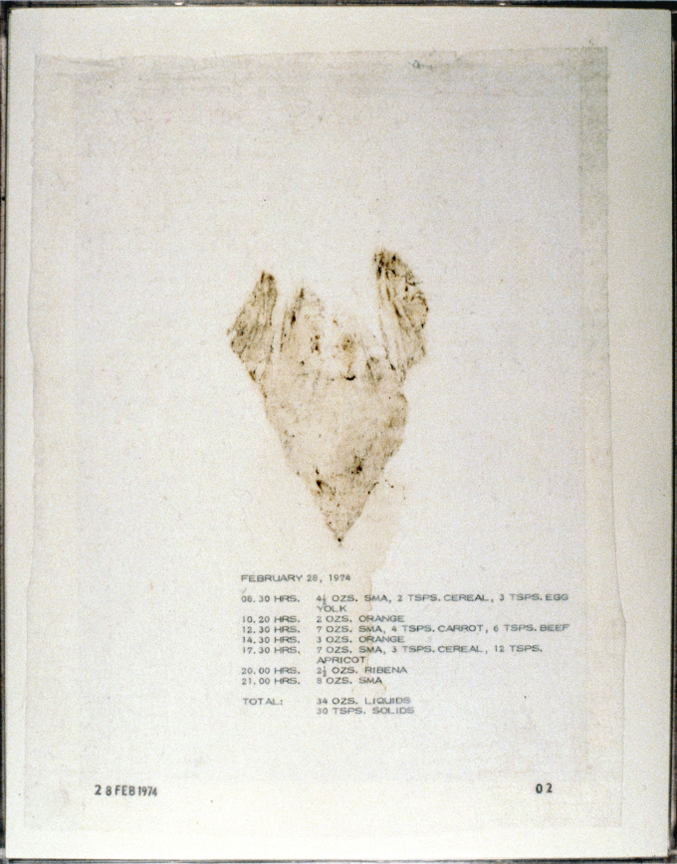
- Dated work and well as numbered – indicating it is part of a group of work (1 of 28)
- A big stain left by a baby’s stools – the baby’s ‘marks’/ artefacts? .
- Use of text in the work – a printed chart with date, time, amount and type of baby food/drinks consumed. – the mothers ‘remarks’?
- In a very scientific (medical) way it totals the liquids from the solids.
- A scientific chart about ‘event’s that happened – feeding a baby
- I can try to imagine the rest of the works and looking at it all, or a big group as it unfolded over the years – a continuous unfolding narrative of her intimate notes of being a mother who is caring for a small child, but it says nothing about what she as a mother felt, it is very ‘clinical’, is it part of a process of dealing with motherhood and your own body and personal identity?
- Did this mother share her experience of post partum depression (PPD) here?
- Is it a chart of nurturing to make sure you have proof of being a ‘good’ mother?
- In that way this becomes so personal and I feel so much empathy for the artist – then who would think to create a ‘document’ about your child as an art form?
- Having had babies, I think this baby is older than 6months, as it consumes solid foods like cereal and vegetables.
- I am amazed at how regular the baby ate during a span of 12+hours of a day.
- It talks to me about the time it takes to prepare and plan the food, to give the food to the baby and the consequence of dirty and wet nappies (even clothes and bedding at times) a mom/carer has to remove daily.
- It is about being a mother and showing your work of 12.5 hours -caring, feeding, cleaning, preparing.
- Thinking about the time in between as shown on the chart – did she put the baby to sleep, how long? – did she walk around and played with the baby–how long? Did she feel tired, other emotions of feeling guilty?
- I am reminded of the all consuming impact of a baby on my life – the first child.
- I reminds me of this new and complex relationship I was forming, in a way very natural, but also so intrusive. But you have that nurturing and protective side of which I became so much more aware in this time.
- I always thought that I was lucky to have a husband who was a General Practitioner, to calm my anxiety about the baby’s physical health – but I remember the loneliness of struggling with the chores of motherhood. My mother lived more than a 1000km from me – did not have a fultime nanny to help. I breastfed – concerns like is it enough, being tired of the long hours of care – constant guilt.
- We used towel nappies – the laundry was a nightmare. Remember the routines of buckets filled with water and nappy cleaner (steri nappy :)and moving the dirty nappies over to the solution to keep stains at bay, the washing/scrubbing. (at least I had a washing machines and clothes drier to get them soft and ready to use again – what a cycle!)
- I was thinking about what I kept of my first child, compared to the next two – baby photos, hospital chart of the birth weight, little book with notes, like your first smile, your first solid foods, your first steps…..then there is the umbilical string, shoes, clothes, blanket, toys somewhere in a box.
- I think of my own baby things my parents kept and I still keep – somewhere in a box ( little gold bracelet, christening dress, photos – and stories they shared – the many dummies I had….)
Women & Work: A document on the division of labour in industry, 1975
(with Margaret Harrison and Kay Hunt) Black and white photographs, charts, tables, photocopied documents, film loops, audio tapes
Dimensions variable Installation, South London Art Gallery, London
Collection Tate Britain
Night cleaners was intended as a propaganda film, but became a seminal work of documentary art.
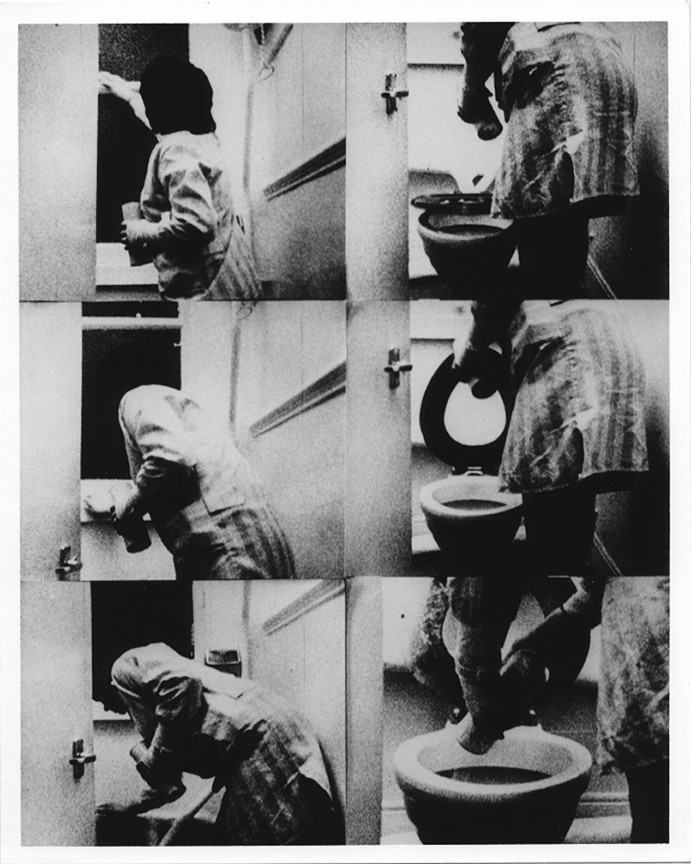
- A black and white video showing a woman cleaning a toilet
- A job which is often ‘unseen’ as well as ‘lowly’ – not appreciated as a work, like all cleaning jobs. Can this be a perspective that has been change over time?
- Woman cleaning a toilet bowl as well as the area around
- Woman cleaning the window above the toilet
- We experience this almost everywhere we move in a city, here in Dubai in the Malls as well as public areas – cleaners are always cleaning up after people.
- Cleaning is often done outside normal working hours, frequently in the early morning, evening or night.
- The woman cleaning may be employed on part-time and temporary contracts and could even be doing more than one job.
- As a women, I feel embarrassed to see other people clean after me – especially a toilet, bath, basin, shower.
- Words like dignity and respect come stand in front of me.
- Do we create jobs to grow an economy or do we maintain a workers class by defining jobs, such as cleaners as a type of ‘forced’ labour? and how does this impact on equal pay, equality and non-discrimination at work.
- Do we hold cleaners and the work they do in low regard?
- It is not a ‘nice’ experience to clean toilets – imagine it is your job all day!
- I consider safety and health risks – is she protected when she does this work?
- I consider the pay for this job is low and could be a temporary job, paid by the hour?
- She could be the only breadwinner in a family and desperate for any work
- It is a never ending job, but must be very ‘un’ rewarding to continue doing this as a work, due to lack of education or opportunity or not good work conditions.
- In South Africa cleaners, depending if they are employed by a company or work as temporary workers or in private households (migrants, low education, poor) are exposed to bad labour practices – unfair dismissals, long hours, lack of rights like sick leave, pension, holiday. I remember a case where women who claimed they were menstruating and wanted less strenuous work , had to physically show proof by undergoing a humiliating physical examination by a supervisor.
- In South Africa there are also amazing stories of cleaners who paid for their children’s education, bought a house – who transformed within their job.
Reflecting on the question’s direction: ‘Rather than analysing these works through different texts you will critically look at them and bring your own analysis to them‘
I am thinking about what the exercise asked of me, as I have never seen these works other than as these ‘found’ images and stills and some research in earlier chapters of the study material. I looked back to my writings and feel it is appropriate to use the following from Part One, Lived experience within art, where I wrote: “the artist managed to open up the world of conceptual art to a feminist discourse. This is important, as today it is acceptable that men are taking up parenting roles and tasks, without being frowned upon as at the time of this work” I could identify easily being a woman myself, having read about feminism and so aware of many of the contemporary issues one is still being confronted with (violence, abuse, gender/sexuality, power, motherhood….) I did Developmental studies during my Hon for Social Work degree, and have worked with disadvantaged groups in my Social Work practice, but looking at it from the artwork perspective is so much different. I understand the value of viewer participation within these works – so much the same as any other form of action/activism – getting people to take up your ideas, identify with it, so that change can follow.
I do think what I also appreciated from these works is than it is not about how women differ from men, but how power relationships and patriarchal discourses defined woman as the other and stereotyping roles which oppress women to the extent that they became victims.
I feel I was challenged to be comfortable with the fact that there is no right way to understand an artwork or text, but that by analysing and interrogating these works, I will gain confidence with regards to how others view my work and how I can think in my own practice. I think it has to do with the broadest sense of these works – as feminist artists explored over the years, there is a ‘history’ to look back on, to reflect and evaluate in terms of successes and as well as current issues. Here I look to my reading about Barthes’ from whom we learnt that meaning is not in the ‘origin’ of the text but in its ‘destination’. We all bring out own experience to a work of art – hence the infinite number of meanings that could be possible. It was also Barthes who eluded to move ‘towards a world where differences would not be synonymous with exclusion.
I decided to look at audio archives of artists interviews as discussed in the study material (p 11) and used the Women’s Audio Archive for this purpose. ( https:www.marysialewandowska.com/waa/index.php Accessed on 12 January 2021
The first audio I listened to appeared to be the first occasion the group have come together under the banner of ‘Feminist Art History’, and they are divided according to whether there should be women only spaces within the conference. There are also men in the group. I listened to the photographer, Jo Spence: below is a summary as found on the site.
Jo Spence; London, Battersea Arts Centre; 21/9/85
British photographer Jo Spence (1934-1992) was famous for documenting her battle with breast cancer. Spence was doing studio photography before founding the left-wing, feminist art collective: ‘The Hackney Flashers’.
I learn that the Hackney Flashers was a women’s arts collective active between 1974 and 1980. Most of the group were photographers and defined themselves as socialists and feminists. (TATE) The name was a playful pun on the flash of the camera, their medium of choice. They used documentary photography as a tool in their activism. Their work was focused on Hackney, East London, an area where poor people lived at that time. ( a google search describe current day Hackney as: Formerly one of London’s industrial epicentres, Hackney has come a long way in recent years. Nowadays, it’s a chic hipster hub cultivating a playfully artistic ambience that permeates the borough. With everything from parks and canals to murals, street food and a host of great pubs and bars, is it any wonder Hackney is so popular with millennials? (culture trip) It seems gentrification has become a new problem for artists living in this area – being priced out of a studio space due to ‘re’ development.
Back to the audio: “As a producer of images, Spence grappled with the placement of female identity, in particular the space between ‘representation’ and ‘actuality’. Spence was diagnosed with breast cancer in 1981. By 1985, when this recording was made, the artist had turned to her own body as a subject for exploration of images and politics. Producing a body of work entitled ‘A Picture of Health?'(1982-1991) she scrutinised the relationship between doctor and patient, and institutional power structures.“
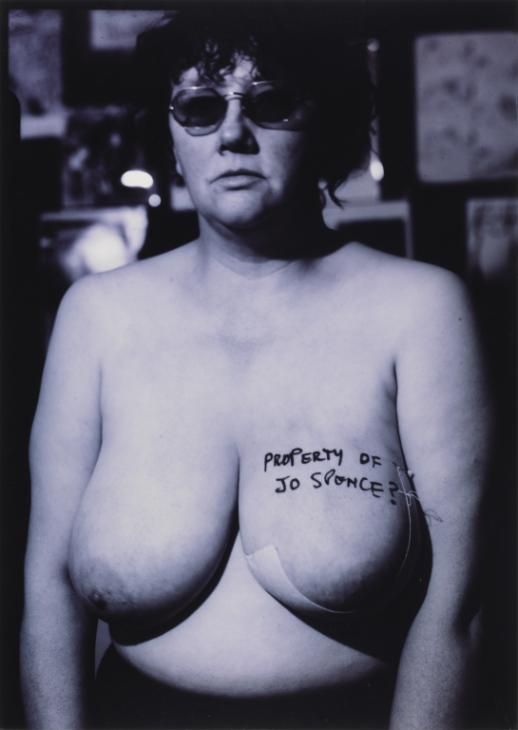
Exercise 5.1: Silvia Kolbowski
Refer back to feminist practices covered in the course so far. Look up the work of Silvia Kolbowski. How do feminist critical practices today differ from those from earlier generations? Write 250 words in your learning log identifying the differences and their significance.
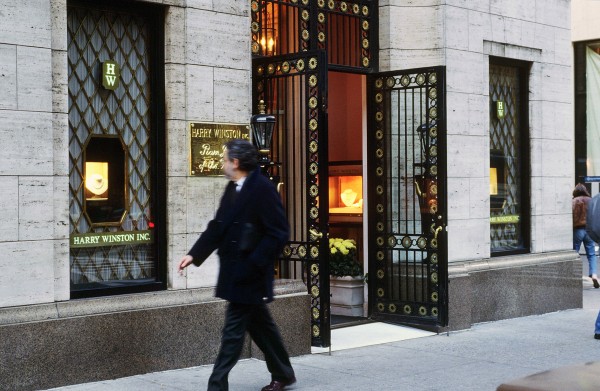
These two images shows a work of Silvia Kolbowski, called her Harry Winston project: She would advertise it as : “An example of recent work may be found in the windows of Harry Winston Inc., from approximately 5:17 to 5:34 pm, 1990, New York. General view.” Photo courtesy of the artist.
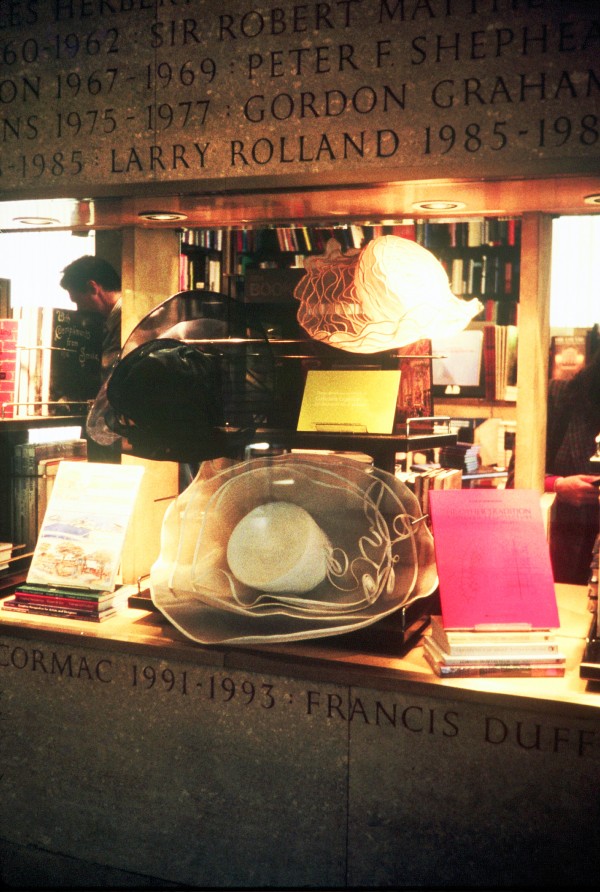
The artist gathered objects which was sold in shops in SoHo and arranged them in an ‘installation-like shape’ while galleries were moving over to Chelsea to avoid that “commercialism” – seem to carry an ambiguous and complex understanding of critical practice as they pose questions like: What are the prerequisites for a critical practice and how is it embedded in the commercial circuit? What are its financial resources, and what are the forms of safety and affluence needed to act critically? Why do these topics usually appear excluded from each other?
Feminist critical practices : Differences and their significance
Earlier generations: I think it is important to take note of the fact that Feminism started as a Western consciousness and have in a way opened opportunities for change for most women over the world, regardless of the the founding drivers. Artist focussing on empowering women in the early 60sand 70s was mostly around issues of motherhood and equality issues with work as a woman – one see an emphasis on identity of woman in society, that of feeling and being overlooked, being dominated in the workplace by a male society. On the theoretical and art historical side there where also efforts to question the male artist and patriarchy’s definition of artistic ‘greatness’ (institutions and ideologies who clung to this myth) So it is very much issues of gender roles and how these were stereotyped in society, as well as institutionalised. Female artists were supported by feminist writers, anthropologists, art historians, filmmakers, photographers, etc. I am thinking about Susan Sontag – she did not value the idea of ‘pigeonholing’ her career as a writer and thinker only as to be feminist. She was a single mom, an academic with strong views, but did not appreciate being put into a category.
I read that the first women’s art organisation in the USA was called the Women artists in Revolution (WAR), and it started as a splinter group in 1969 of the Art Workers Coalition, who was seen as being indifferent to women’s issues. During these years woman artists started putting pressure on galleries and museum exhibitions who almost completely excluded women in their exhibitions.
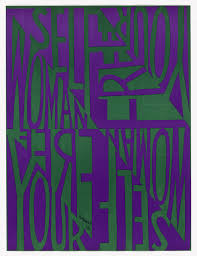
I also think there was a focus on working class woman and the struggle for equality in the workplace, where as sexual harassment has gain a stronger awareness in recent years. I also think it is important to look at how ‘inclusive’ these actions were – in terms of race and culture. I discovered that Faith Ringgold and her daughter M Wallace organised and eventually a Black women artist organisation was created by 1971, and called Where We At. It seems feminists were seen as militant and many Black artists felt more comfortable to address issues of race, rather than gender.

I also learnt that politics of identity started in the 80s and here we were referred to work of Jo Spence who addressed issues of class, gender
and inequality.
Background on Silvia Kolbolski’s practice around feminism as practice and critique
Silvia Kolbolski focus mostly on spectatorship, how the mass media constructed woman for the pleasure of the male gaze. In the late 1980s, she was analyzing display, power and consumption within the format and spectatorship in the way art were accruing value through the institutions of art. Recently her work is exploring current political, psychic and ethical issues, as well as anxieties. Her worked moved from being ‘appropriationist’ to site specific, where she worked mostly alone, and not within a group. Her projects relate to urban sites that require little or no government approval. The images of her work above is in a store front, opposite the Trump towers, and only on ‘display’ when the store closed in the evenings, at a certain time on display. She clearly looked into the spaces where art can be: “I would have to say that the 1970s work of Michael Asher began to be of great interest to me in the mid- to late-1980s. I came late to that work, but his historical comment – “Why put something on the wall? Why put something on the floor?” – resonated deeply with me.” ( interview with Brzek, 2020) In 2020 Dennis Brzek writes about her work as follows: “Her work demonstrates a relentless quest for the meeting point of criticality and aesthetic form, developing a broad practice that ranges from site-specific interventions to appropriating different media as well as editing, writing, and teaching. Looking at how her works have changed form over the years enables the experience of an artist’s steady confrontation with psychological and political powers, all the while discussing art’s position as a tool of critique and its direct complicity. ” Her works are informed by aspects of feminist and psychoanalytic theory. For example, in an early series, Model Pleasure, she appropriates images of women from mass-media sources to create grids of images that make allusions to the ways that women are defined by media.
I also became aware of the use of relational aesthetics : Term created by curator Nicholas Bourriaud in the 1990s to describe the tendency to make art based on, or inspired by, human relations and their social context ( Tate) In her work one sees an artist becoming a facilitator – giving power to the viewer?
Brzek, Dennis, 2020 Interview Silvia Kolbowski , 02 October 2020 at http://artsoftheworkingclass.org/text/interview-silvia-kolbowski, accessed on 10 January 2021
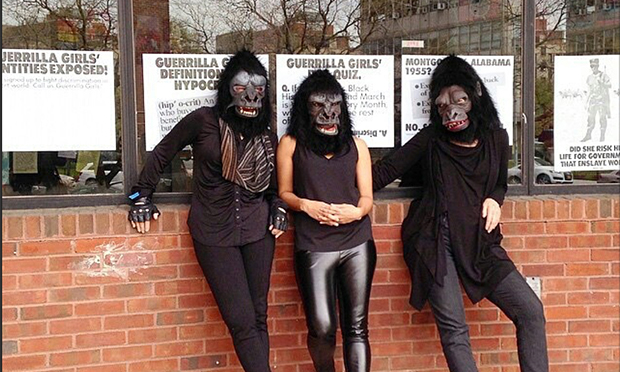
Exercise 5.2: Current feminist art
Research two other artists that are currently dealing with gender identity in their work. Describe their work and the different approaches that they take in your learning log.
Billie Zangewa is a South African based artist, born in the seventies in Malawi, who works mainly with silk fabric. Her work started with a focus on the male gaze, and grew into an experience of herself as a woman and then recently a mother within a patriarchal society, all within a domestic scene.
One could see her as merely working a craft, but she believes the best way to fight the patriarchy is not by going to war with it but, rather, by showing one’s appreciation of and solidarity with domesticity and femininity. I listened to a conversation with her on Tate Youtube channel (the Ultimate Act of Resistance is Self-Love| TateShots) Her work address Black woman, a marginalised group – I feel she connects with viewers through these narratives in her work – she focus on the mundane, universal themes of daily living. Her stitching with and on fabric (cut out images/colours) as material work process is like weaving in narrative with stitches into a collage, and relates to history of traditional African stitching. I see it as very connecting with viewers – an opportunity to talk about issues concerning gender and feminism, even taking it closer to home, a situation is created to talk about how Black women relate to feminism?
Exercise 5.3: Changing identity
Choose one work by John Akomfrah and research how he approaches and communicates the subject of identity in his work.
I had to get myself acquainted with his work and found an interview with him on Frieze.com. I choose to look at Four Nocturnes (2019), a new three-channel piece that reflects on the complex intertwined relationship between humanity’s destruction of the natural world and our destruction of ourselves. I realised that I saw the installation at the Venice Biennale in 2019.
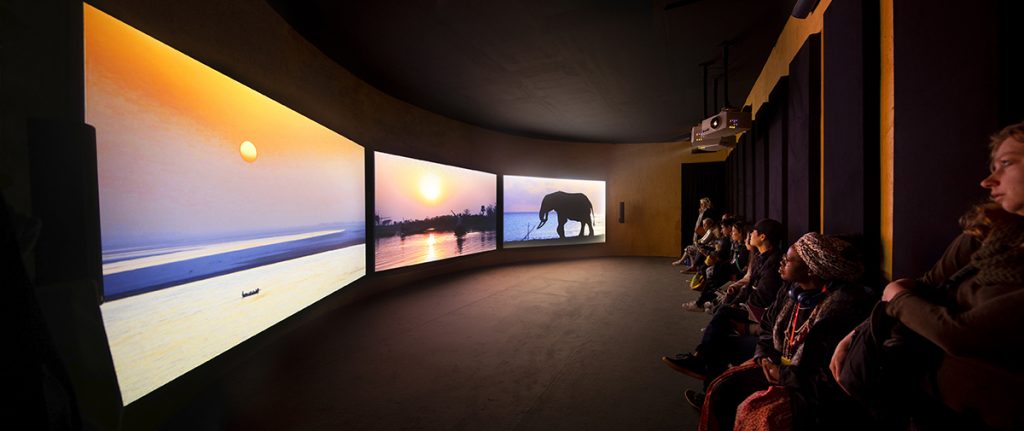
Four Nocturnes is about people over a long span of time you have felt how forces of disruption shaped their lives. He used in this three-screen video installation, Elephants in the Room part to address Africa’s declining elephant populations as its narrative spine. One view these overwhelming scenes of celestial spectacles – like constantly re-forming clouds that contribute to the formation of rain, counteract the hot desert wasteland in which the people are with beautifully glittering close-ups of water. Aerial shots over different natural areas alternate, taking the viewer on a meditative flight over the African landscape. The other two videos shown was Vertigo Sea (2015) and Purple (2017)
The film questions mortality, loss, fragmented identity, mythology and memory – of a landscape of African cultural heritage. Within identity one see this complex intertwined relationship between how humanity is destructing the natural world, as well as ourselves.
Something that I have taken from listening to this artist is how he understands finding a voice in a space where people need to adapt – a voice which is of (about)becoming, and not mimicking (parrotlike) but with an insight which is not to come in harmony (there is rage in the despair of the situation). Learning that we we should look as the discord within these voices.
I looked at the artist Hazem Harb, a Palestinian artist who is always in dialogue with his (lost) homeland. I visited him in his new studio here in Dubai recently and saw this work below, which he hopes will become part of a museum collection. In this work on sees a fragmented ideo of the pre-Nakba history of Palestine. When one look at how artists bring to the fore the forgotten and marginalized, one looks at this work with the question of how art can have the power to explore memory, heritage and the power over who writes history, what and to whom they choose to write to. He shared with me that some of his work are now in the permanent collection of the Pompidou Centre, Paris.
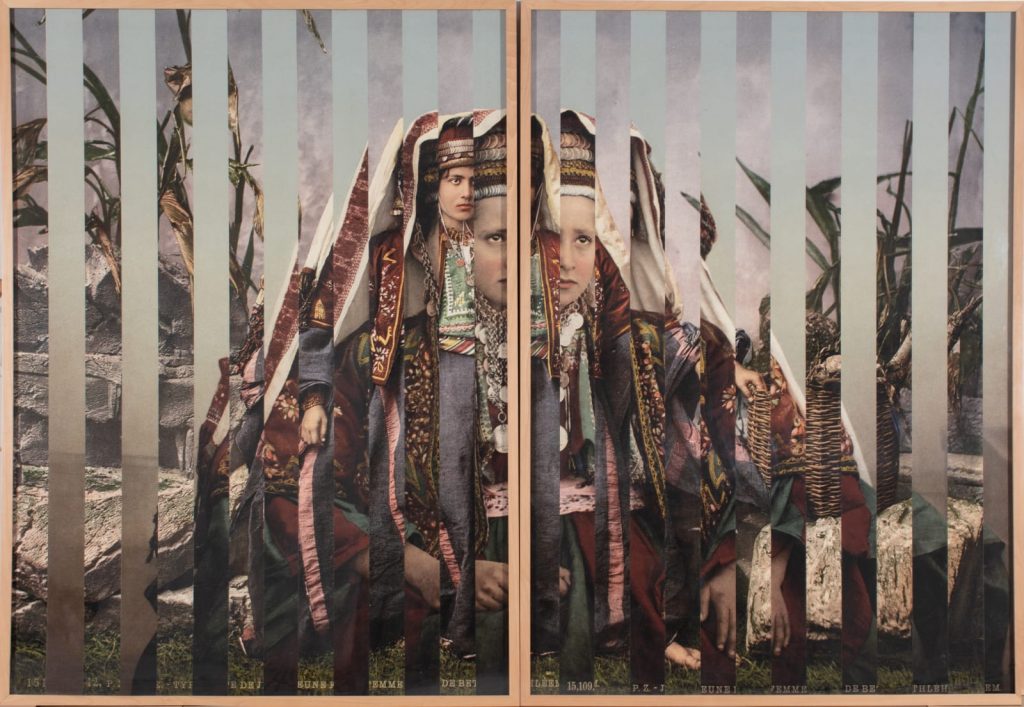
In my research on feminism in the Arabian region I read that in occupied Palestine, for example, the feminist ( mostly non-governmental organizations) and activists, are losing their power and popular bases in favor of Islamists because of the de-politicization of their gender agenda and the discarding of the colonial context. Clearly one has to look deeper and understand the many layers of oppression whether it stems from colonialism, patriarchy, class, race, color, disability or age. Feminism as a movement can act as a catalyst for change, as well as being an empowering state of mind for women.
Exercise 5.4: Intersectionality
The three subheadings: Gender, Cultural identity, Inequality/the status quo are very much interconnected and artists may be addressing all three in addition to other concerns. There are many examples of this in this part of the course. Choose one work by an artist of your choice that demonstrates this and write a short paragraph in your learning log.
What is your reading of it? How do the 3 categories interconnect? How does the work affect you?
How do I understand Intersectionality within my current learning (course material)? Our lived experience is clearly very complicated – what is my identity when I include race, class, gender, ethnicity, sexuality into the pot and then put this in the cooking pot of where I live – the political, cultural, and economics of the powers that rule. When I choose an artist am I seeing the work interconnecting or affecting me because I can relate to feeling oppressed, shame, humiliation, anger, blamed for, ignored, being part of a minority (female?). Do I think about this in my own work practice? How important is this to me?
I will be looking at the work of Adrian Piper. I think what I learnt from her perspective is to start at the effects of WW2, when women had to start working in societies that were at that stage directed towards a different view of the role of gender, identity and inequality. Social disruptions and dislocations was happening within society. After the war, governments wanted the status quo of the before and attempted massive domestication campaigns to persuade women to return to the status quo of taking up their traditional roles as housewives. Piper shows in her work that this campaign was taken into the politics, economics and cultural spheres of society.
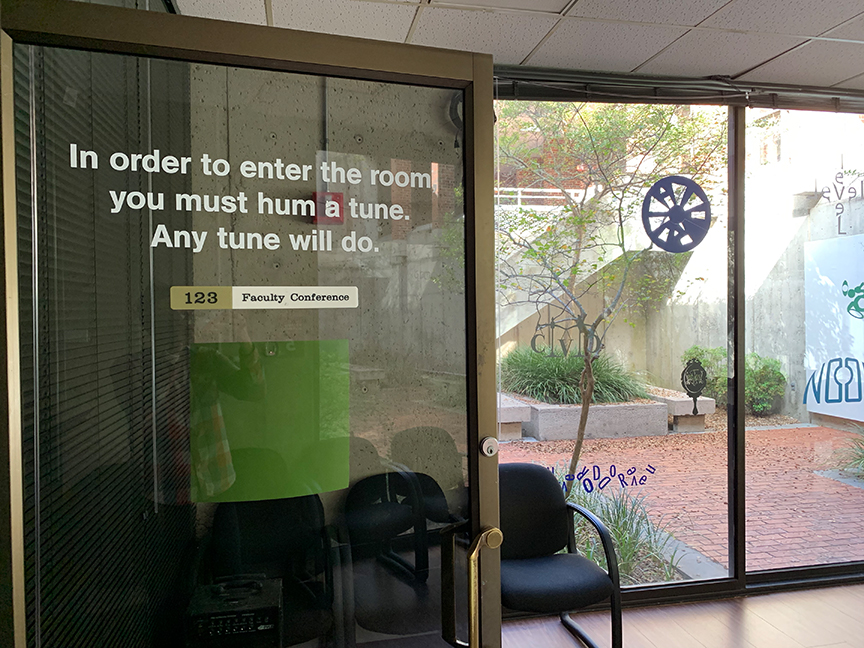
Voluntary group performance. Full-time museum guard, empty room
equipped to echo, and two text signs, one above the door and one adjacent
Dimensions variable
Installation view in Do It 2013, Manchester Art Gallery, U.K., July 5–21, 2013
Collection Adrian Piper Research Archive Foundation Berlin
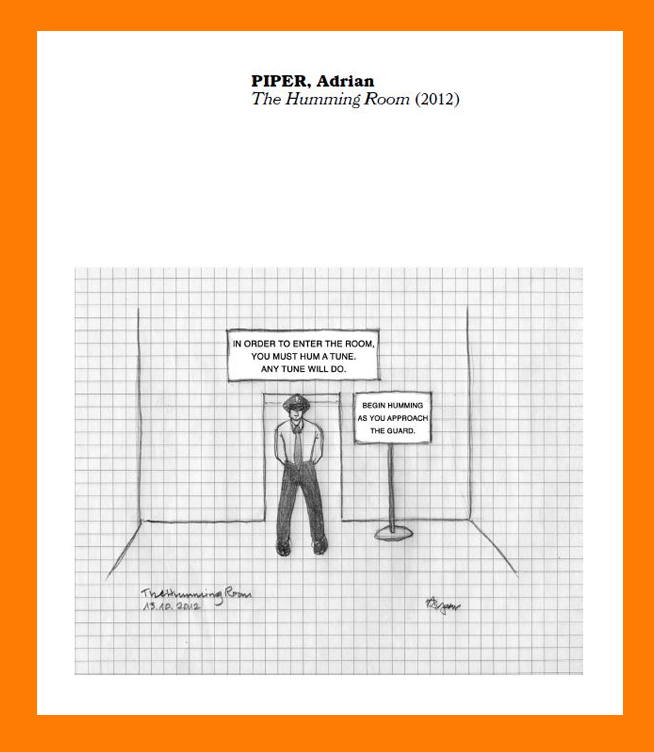
Exhibition instruction. Pencil on graph paper with digital additions
8 ½ × 11 in. (21.6 cm × 27.9 cm)
Collection Adrian Piper Research Archive Foundation Berlin
With above work she ‘helped’ the viewer to consider authority – you could not continue with the rest of the viewing if you did not enter this room, and by entering, you had to do what she asked, you had to hum a tune. I find it very intriguing, absurd and humoristic at the same time. The artist is not even there when you read or consider the ‘instruction’. Do I see the work as being aggressive of confrontational? I am not even sure – I see pretentiousness of institutions and authority, and want to detach my own self worth from that which I am being told I am or should be, or can be. I have to ask myself some quesions, like:
How critical am I of the rules I obey in society?
Do we need validation from institutions as artists, as viewers of art?
Can we just laugh at it, walk away and hum a tune – like not let them get us to become aggressive?
I like the questions this work left me with.
I feel it touched Gender, identity, inequality.
In my recent daily drawings I have been looking more closely at my subjects – doing more observation and analysing line (structure). Line is in many ways how we investigate our object/subject when we draw. I feel a need to develop slow and gentle lines in order to observe better, not to draw what I think I see. At best it would be to bring in what I hear, feel, touch, smell, and here my walking practice adds to growing my observation skills in my practice. In many ways that is the way I would like to look at this part of the course.
In my walking I collect found objects – things that have meaning at that time, a curiosity as well. Sometimes I can go back to the studio and just work with colour and lines – memories of a walk becomes an exercise, but it could not have happened if I was not open to what was around me (watching the ocean) and thinking and noticing about the small differences, mapping to remember (reflection?). I think about being and feeling safe as a woman in this country in terms of doing things on my own; I can walk anywhere without being harassed or threatened – I feel safe in this environment – how many women do have this experience? I walk when and where I choose to walk – authority is mine in many ways – many rules about public space and using it, protect me. There is also knowledge, instinctive that reminds me that not all women in my area are experiencing this same level of freedom of choice when it comes to physical movement and having the authority of doing things on her own. I am aware of political decisions made by the leadership to show tolerance and hope this lead to many more transformations with regards to movement and choices about it.
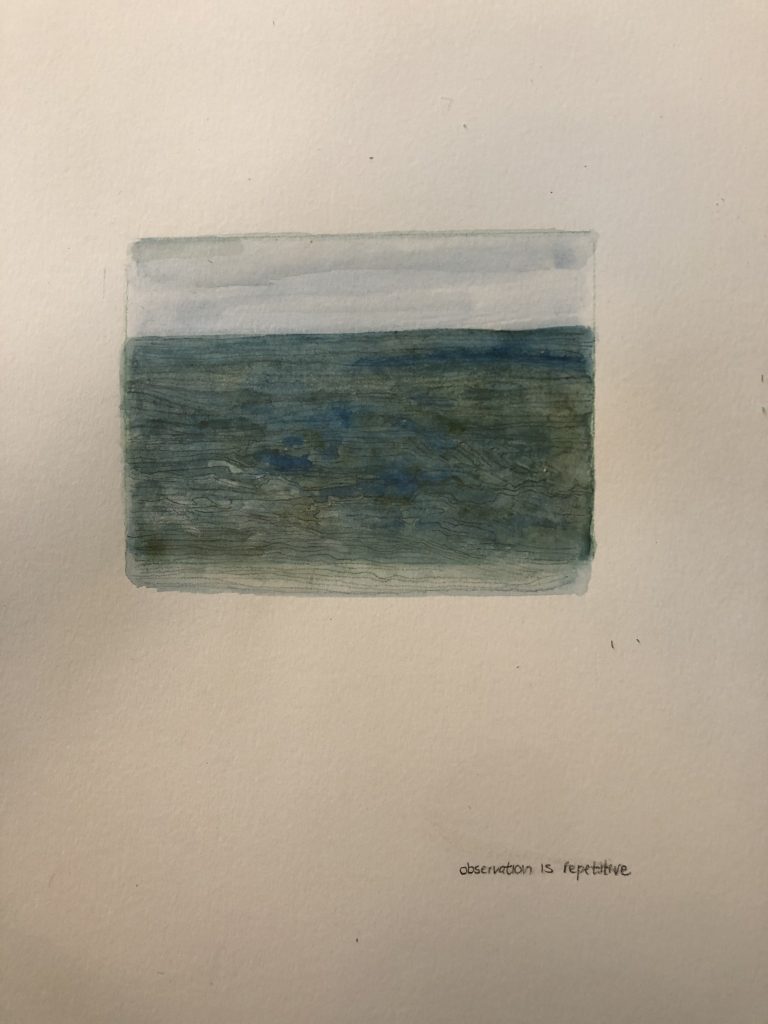
Ideas to research for better understanding:
I also want to do more on the concept of The Other. As this highlights how societies create a sense of belonging, identity and social status by constructing social categories as binary opposites. I never realised how this is much more in the social construction of gender in Western societies, or how socialisation shapes our ideas about what it means to be a “man” or a “woman.” It is of interest for me to look to the inherently unequal relationship between these two categories. They as set up as opposites, without acknowledging alternative gender expressions.
I can look at the work of Simone de Beauvoir who argued that otherness is a fundamental category of human thought.
Thus it is that no group ever sets itself up as the One without at once setting up the Other over against itself. She argued that woman is set up as the Other of man. Masculinity is therefore socially constructed as the universal norm by which social ideas about humanity are defined, discussed and legislated against. ( more reading from https://othersociologist.com/otherness-resources/?fbclid=IwAR0Y0sP6Ucrufi0tO1vgzJauA1IOomCah7gDdLCIvv4yM5LgAo9lispwiH0)
There is also the work of Hachivi Edgar (edgar heap of birds) an artist who seemingly successfully works as a traditional studio painter and as a
political artist. He is of Cheyenne Arapaho descent (from Oklahoma) and his abstract painting are politically charged word pieces. In a way he uses word as weapon to take direct aim at historical narratives that obscure the Native presence in the United States. In his paintings from the Neuf Series, the colors and the left to right pattern are inspired by trees from the western Oklahoma landscape “Neuf” is Cheyenne and means “to do something four times”
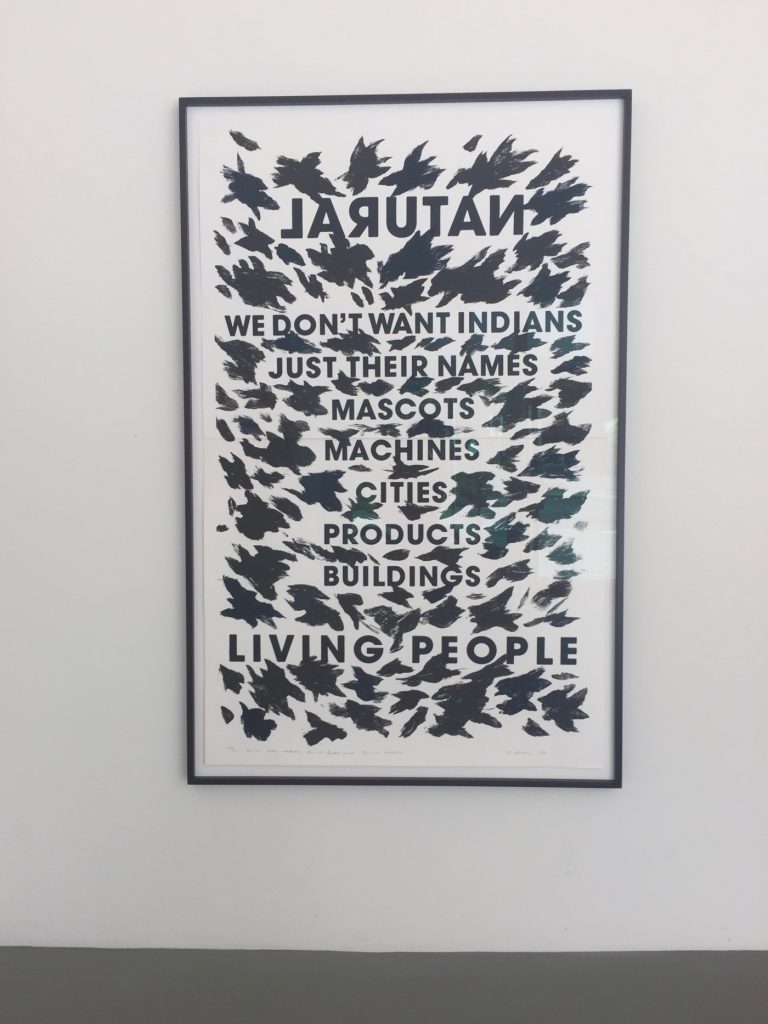
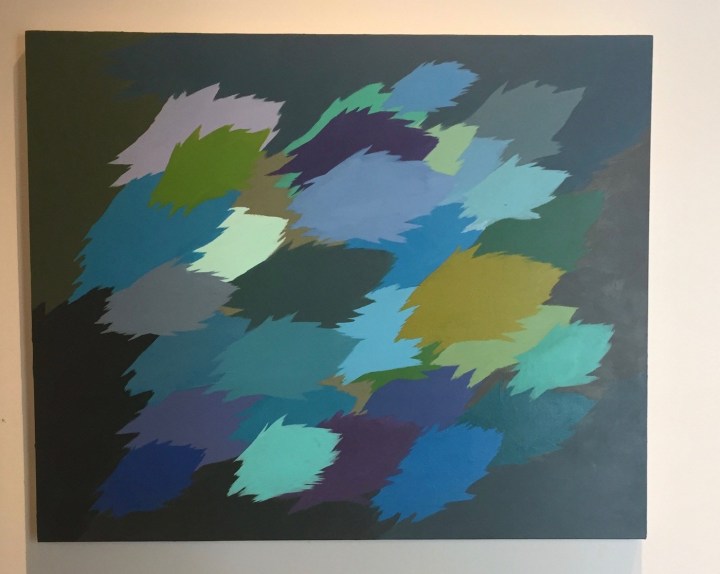
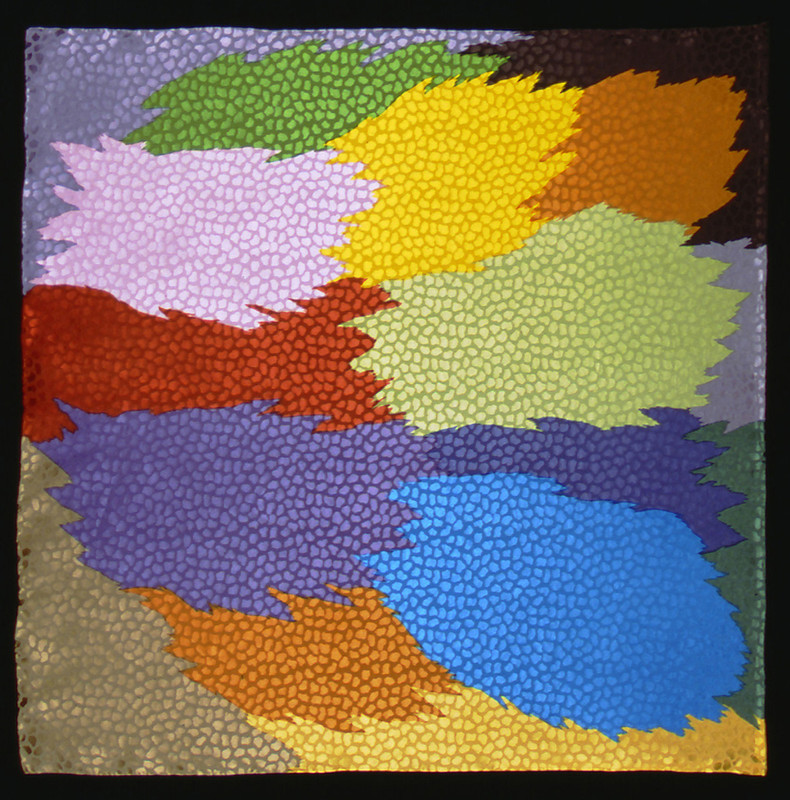
Above work convey the poetry of the hues and colour of the land. In his book about the artist, Anthes notes that these landscapes don’t contain a horizon line or perspective, which refers to ‘tools for colonization in the view of some Native theorists’. “Heap of Birds inserts viewers into the land itself, surrounding them, demonstrating what it means to be a part of the land, rather than mapping it to conquer it. The paintings are meditative and serene, but share a political message with Heap of Birds’s other work.”
My reason for looking into his work is this abrasiveness one can get in art when one is forced to look at the history of a place and indigenous people who lived there before colonialism – things that happened and are hidden in many ways. I became more sensitized to the need to acknowledge – to be seen/heard. I read statement by the Bockley Gallery this during a search on the artist: His artistic creations and efforts as an advocate for indigenous communities worldwide are focused first upon social justice and then the personal freedom to live within the tribal circle as an expressive individual. (http://www.bockleygallery.com/artist_heap_of_birds/index.html)
